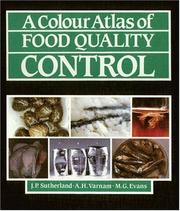| Listing 1 - 10 of 95 | << page >> |
Sort by
|
Book
ISBN: 0443153477 0443153469 9780443153471 9780443153464 Year: 2023 Publisher: San Diego : Elsevier Science & Technology,
Abstract | Keywords | Export | Availability | Bookmark
 Loading...
Loading...Choose an application
- Reference Manager
- EndNote
- RefWorks (Direct export to RefWorks)
Food --- Food additives --- Food Quality --- Quality. --- Health aspects.
Book
Abstract | Keywords | Export | Availability | Bookmark
 Loading...
Loading...Choose an application
- Reference Manager
- EndNote
- RefWorks (Direct export to RefWorks)
Materials and equipment in food processing industries are colonized by surface-associated microbial communities called biofilms. In these biostructures microorganisms are embedded in a complex organic matrix composed essentially of polysaccharides, nucleic acids and proteins. This organic shield contributes to the mechanical biofilm cohesion and triggers tolerance to environmental stresses such as dehydratation or nutrient deprivation. Notably, cells within a biofilm are more tolerant to sanitation processes and the action of antimicrobial agents than their free living (or planktonic) counterparts. Such properties make conventional cleaning and disinfection protocols normally not effective in eradicating these biocontaminants. Biofilms are thus a continuous source of persistent microorganisms, including spoilage and pathogenic microorganisms, leading to repeated contamination of processed food with important economic and safety impact. Alternatively, in some particular settings, biofilm formation by resident or technological microorganisms can be desirable, due to possible enhancement of food fermentations or as a means of bioprotection against the settlement of pathogenic microorganisms. In the last decades substantial research efforts have been devoted to unravelling mechanisms of biofilm formation, deciphering biofilm architecture and understanding microbial interactions within those ecosystems. However, biofilms present a high level of complexity and many aspects remain yet to be fully understood. A lot of attention has been also paid to the development of novel strategies for preventing or controlling biofilm formation in industrial settings. Further research needs to be focused on the identification of new biocides effective against biofilm-associated microorganisms, the development of control strategies based on the inhibition of cell-to-cell communication, and the potential use of bacteriocins, bacteriocin-producing bacteria, phage, and natural antimicrobials as anti-biofilm agents, among others. This Research Topic aims to provide an avenue for dissemination of recent advances within the “biofilms” field, from novel knowledge on mechanisms of biofilm formation and biofilm architecture to novel strategies for biofilm control in food industrial settings.
Biofilms --- Biofilm formation --- food quality --- Food Safety --- Biofilm architecture --- biocontrol
Book
ISBN: 9780081017661 0081017669 0081007647 9780081007648 Year: 2018 Publisher: Duxford, England : Woodhead Publishing,
Abstract | Keywords | Export | Availability | Bookmark
 Loading...
Loading...Choose an application
- Reference Manager
- EndNote
- RefWorks (Direct export to RefWorks)
Food --- Microbiology. --- Quality. --- Food quality --- Quality of food --- Quality of products --- Sanitary microbiology --- Bacteriology
Book
Year: 2017 Publisher: Frontiers Media SA
Abstract | Keywords | Export | Availability | Bookmark
 Loading...
Loading...Choose an application
- Reference Manager
- EndNote
- RefWorks (Direct export to RefWorks)
Throughout the food processing chain and after ingestion by the host, food associated bacteria have to cope with a range of stress factors such as thermal and/or non-thermal inactivation treatments, refrigeration temperatures, freeze-drying, high osmolarity, acid pH in the stomach or presence of bile salts in the intestine, that threaten bacterial survival. The accompanying plethora of microbial response and adaptation phenomena elicited by these stresses has important implications for food technology and safety. Indeed, while resistance development of pathogenic and spoilage microorganisms may impose health risks for the consumer and impart great economic losses to food industries, reduced survival of probiotic bacteria may strongly compromise their claimed health benefit attributes. As a result, substantial research efforts have been devoted in the last decades to unravel the mechanisms underlying stress response and resistance development in food associated microorganisms in order to better predict and improve (i) the inactivation of foodborne pathogens and spoilage microorganisms on the one hand and (ii) the robustness and performance of beneficial microorganisms on the other. Moreover, the recent implementation of system-wide omics and (single-)cell biology approaches is greatly boosting our insights into the modes of action underlying microbial inactivation and survival. This Research Topic aims to provide an avenue for dissemination of recent advances within the field of microbial stress response and adaptation, with a particular focus not only on food spoilage and pathogenic microorganisms but also on beneficial microbes in foods.
food safety --- stress response --- pathogens --- spoilage bacteria --- bacterial stress response --- food quality --- food microbiology --- food preservation

ISBN: 0723408157 Year: 1986 Publisher: London : Wolfe Publishing,
Abstract | Keywords | Export | Availability | Bookmark
 Loading...
Loading...Choose an application
- Reference Manager
- EndNote
- RefWorks (Direct export to RefWorks)
This extensively color-illustrated atlas serves as a comprehensive guide not only to persons actively involved in food quality control but also to students and trainees, as well as to nontechnical food in-dustry personnel who wish to enhance their product knowledge. Each chapter is devoted to a commodity group (e.g., fresh meats) with two non-commodity chapters concerned with precepts of food quality control and foreign bodies and infestations. Those foods similar in nature and which could be placed in more than one chapter are cross-referenced. Illustrations were selected based on those quality defects most commonly encountered at retail or final inspection level, together with less common defects which illustrate a point of particular signif-icance. Rare cases of actual spoilage or visible quality dete-rioration of some shelf-stable products are provided to serve as a reference point. Particular attention in this respect is paid to "exotic" imported goods such as Oriental fermented products, the nature of which may be unfamiliar to many persons involved in food inspection. Covers Technical Aspects of Quality Control The atlas is primarily concerned with the technical aspects of qual-ity control. The visual faults illustrated are related to the manufac-turing technology involved, where possible, in order to identify their cause. In addition, examples of laboratory tests which may be of value in confirming visual diagnoses are included. Food poisoning agents (microbial or chemical in nature) which cannot usually be de-tected by visual examination and specific problems of a public health nature are also discussed.
voeding --- Nutritionary hygiene. Diet --- Bacteriological laboratories --- Food --- Food contamination --- Food poisoning --- Aliments --- Intoxications alimentaires --- Microbiology --- Methodology --- Contamination --- Agrotechnology and Food Sciences. Food Sciences --- Food Quality and Safety --- Voeding : kwaliteitscontrole --- 641.1 --- Food Quality and Safety. --- Methodology.
Book
Year: 2019 Publisher: Frontiers Media SA
Abstract | Keywords | Export | Availability | Bookmark
 Loading...
Loading...Choose an application
- Reference Manager
- EndNote
- RefWorks (Direct export to RefWorks)
This eBook is a collection of articles from a Frontiers Research Topic. Frontiers Research Topics are very popular trademarks of the Frontiers Journals Series: they are collections of at least ten articles, all centered on a particular subject. With their unique mix of varied contributions from Original Research to Review Articles, Frontiers Research Topics unify the most influential researchers, the latest key findings and historical advances in a hot research area! Find out more on how to host your own Frontiers Research Topic or contribute to one as an author by contacting the Frontiers Editorial Office: frontiersin.org/about/contact
Proteomics --- Mass Spectrometry --- Foodborne bacteria --- Probiotics --- foodborne pathogens --- Cell surface proteins --- food quality --- Food Safety --- Human health
Book
ISBN: 9020127446 Year: 1993 Volume: vol *24 Publisher: Deventer Antwerpen Kluwer
Abstract | Keywords | Export | Availability | Bookmark
 Loading...
Loading...Choose an application
- Reference Manager
- EndNote
- RefWorks (Direct export to RefWorks)
Production management --- Nutritionary hygiene. Diet --- Bedrijfsorganisatie --- Organisation des entreprises --- Kwaliteitszorg ; voedingsmiddelen --- Agrotechnology and Food Sciences. Food Sciences --- Food Quality and Safety --- 641.1 --- 664.017 --- 658.56 --- kwaliteitszorg --- levensmiddelen --- 664 --- Kwaliteitszorg : levensmiddelen --- Foodstuffs from the point of view of properties. Nutritional value --- Properties of preserved foods and foodstuffs. Food quality --- Quality control. Control of tool issue, materials, products etc. --- Food Quality and Safety. --- 658.56 Quality control. Control of tool issue, materials, products etc. --- 664.017 Properties of preserved foods and foodstuffs. Food quality --- 641.1 Foodstuffs from the point of view of properties. Nutritional value
Book
ISBN: 1845699521 1845695631 9781845699529 9781845695637 9781439830956 Year: 2010 Publisher: Boca Raton, Fla. : Oxford : CRC Press ; Woodhead Pub. Ltd.,
Abstract | Keywords | Export | Availability | Bookmark
 Loading...
Loading...Choose an application
- Reference Manager
- EndNote
- RefWorks (Direct export to RefWorks)
Cereal grains are essential to our dietary needs, as well as for animal feeding and for industrial processing. Consumer needs can only be met by managing quality at all stages of the grain chain. Quality evaluation is also needed at each step for effective management. Cereal grains: assessing and managing quality provides a convenient and comprehensive overview of academic research and industry best practice in these areas.After an initial chapter introducing the themes of the book, further chapters in Part one review cereal grain morphology and composition and the diversity of uses of
Grain. --- Food --- Quality. --- Food quality --- Quality of food --- Quality of products --- Breadstuffs --- Cereal grains --- Cereals --- Grains --- Botany, Economic --- Field crops --- Flour --- Food crops --- Seed crops
Book
ISBN: 9535152793 9535105604 Year: 2012 Publisher: IntechOpen
Abstract | Keywords | Export | Availability | Bookmark
 Loading...
Loading...Choose an application
- Reference Manager
- EndNote
- RefWorks (Direct export to RefWorks)
The book discusses the novel scientific approaches for the improvement of the food quality and offers food scientists valuable assistance for the future. The detailed methodologies and their practical applications could serve as a fundamental reference work for the industry and a requisite guide for the research worker, food scientist and food analyst. It will serve as a valuable tool for the analysts improving their knowledge with new scientific data for quality evaluation. Two case study chapters provide data on the improvement of food quality in marine and land organisms in the natural environment.
Food handling. --- Food --- Standards. --- Quality. --- Food quality --- Quality of food --- Quality of products --- Food sanitation --- Handling of food --- Sanitation, Household --- Food security & supply

ISBN: 0674053850 9780674053854 0674032918 9780674032910 9780674057227 0674057228 Year: 2009 Publisher: Cambridge, Massachusetts
Abstract | Keywords | Export | Availability | Bookmark
 Loading...
Loading...Choose an application
- Reference Manager
- EndNote
- RefWorks (Direct export to RefWorks)
That rosy tomato perched on your plate in December is at the end of a great journey - not just over land and sea, but across a vast and varied cultural history. This is the territory charted in Fresh. Freidberg takes six common foods from the refrigerator to discover what each has to say about our notions of freshness. Local livelihoods; global trade; the politics of taste, community, and environmental change: all enter into this lively, surprising, yet sobering tale about the nature and cost of our hunger for freshness.
Food --- Food handling. --- Perishable goods. --- Perishable commodities --- Perishables --- Commercial products --- Food sanitation --- Handling of food --- Sanitation, Household --- Food quality --- Quality of food --- Quality of products --- Quality. --- Labeling.
| Listing 1 - 10 of 95 | << page >> |
Sort by
|

 Search
Search Feedback
Feedback About
About Help
Help News
News